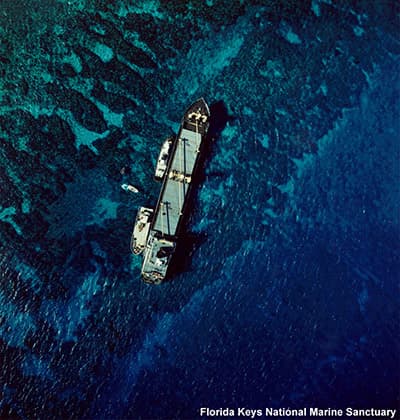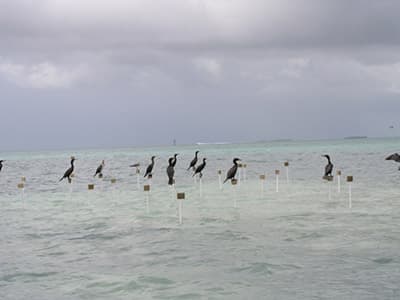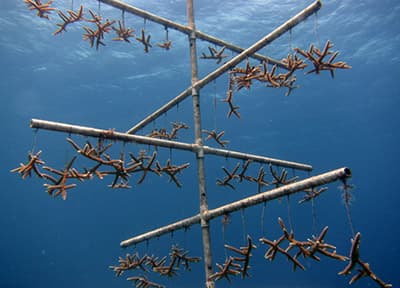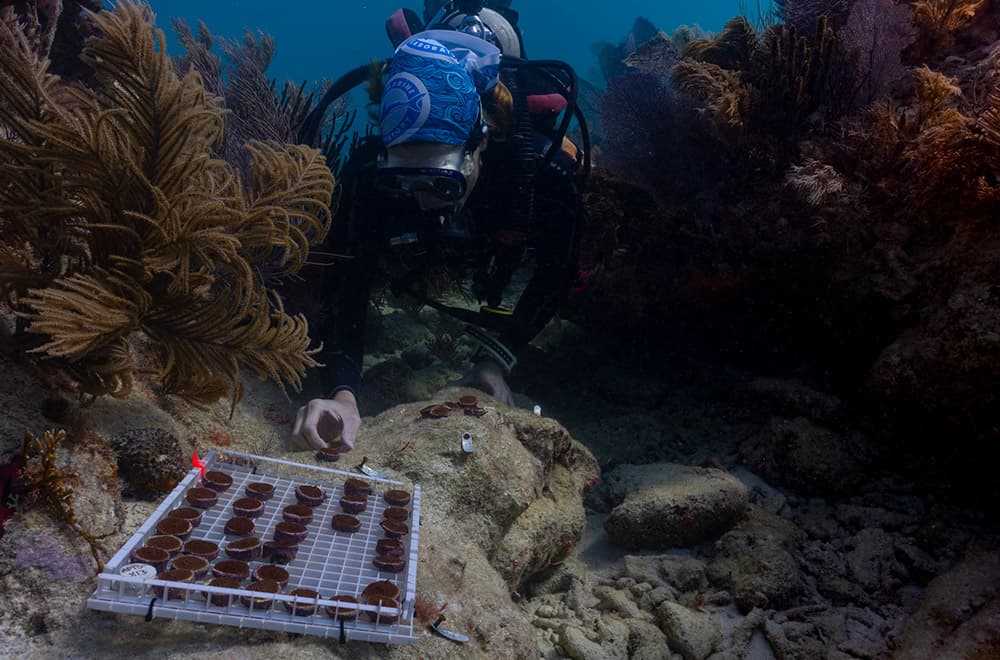Restoration: Providing Hope for the Future
When habitat like coral or seagrass is damaged by a vessel or other human-induced event, Florida Keys National Marine Sanctuary works to restore that area to the condition it was before it was injured. There are many different restoration techniques used by resource managers today, including some pioneered in the Florida Keys! Read on to learn more about the history of restoration in the sanctuary over the last 30 years, and find out what the future holds for this important conservation tool.
Ships Damaging the Reef Elicit Action

Residents of the Florida Keys have always understood the importance of our coral reef, and that this ecosystem is as fragile as it is beautiful. When large ships run aground they can crush, break off, and smother coral, uproot seagrasses, and damage historical and cultural resources. While historical and cultural resources can't be replaced, corals and seagrasses can be restored, thanks to years of research and practice by dedicated professionals.
In the mid to late 1980's, a series of major ship groundings along the Florida Keys Reef spurred action to protect this special place. Within a 17-day period in October and November of 1989, three large ships ran aground on reefs in the Florida Keys causing disastrous impacts and lending urgency to the effort by Congress to designate Florida Keys National Marine Sanctuary in November of 1990. The designation of the sanctuary included an Area to Be Avoided zone for ships longer than 164 feet (50 meters) to keep them away from the reef tract and reduce future groundings.
Upon recognizing the impacts of large groundings, NOAA began pioneering coral and seagrass restoration techniques in Florida Keys National Marine Sanctuary. These techniques have also been applied on a smaller scale to alleviate the impacts of the hundreds of groundings by small commercial and recreational vessels within the sanctuary each year.

Notice to International Mariners: Anchors Away!

All boats may have anchors, but not all anchors are considered equal. While both small and large anchors can cause damage if improperly dropped or mishandled, anchors from large ships can cause catastrophic damage to sensitive deep reef ecosystems. In the late 1990s, scientists began to document significant anchor impacts in the Tortugas region of the sanctuary, which is one of the most heavily trafficked shipping areas in the world. To protect these sensitive ecosystems, the entire Florida Keys National Marine Sanctuary was designated as a Particularly Sensitive Sea Area by the International Maritime Organization in 2002.
This designation, the first in the nation, made sure sanctuary boundaries were clearly documented on international shipping charts and warned large vessels to stay outside of the sanctuary boundary, preventing them from anchoring in the Tortugas Ecological Reserve. This rare form of international protection further demonstrated the importance of the natural and cultural resources protected by Florida Keys National Marine Sanctuary on a global level.
Repairing the Undersea Meadows

While the Florida Keys have long been known for the beautiful coral reefs, other habitats within sanctuary boundaries are also under threat from vessel impacts. Injuries to seagrass meadows can occur from many sources: anchor dragging, propeller scarring in shallow water, blowholes caused by engines of vessels attempting to break free from a seagrass bank, and hull impressions from vessel groundings.

Between 2008 and 2018, Florida Keys National Marine Sanctuary restored over 247,000 square feet of seagrass meadows, the equivalent of 4.5 football fields, which allowed these habitats to continue to act as a nursery ground for commercially important species, trap sediment from water to improve water quality, and support enjoyment through recreation.
The seagrass species found in the Florida Keys are all considered flowering plants with roots and horizontal stems. Unlike the grass in your lawn, the roots of the seagrass cannot grow downward, but instead grow horizontally. This means that when a seagrass bed is injured from a propeller, the seagrass blades at the edge of the scar cannot grow down into the trench, and may begin eroding from the injury.
Seagrass restoration involves scientists filling these scars and blowholes with sediment or sediment tubes to ensure the injury site is favorable for seagrass growth. Other techniques include replanting small plugs of seagrass, and bird roosting stakes, affectionately known as poop sticks, that provide natural fertilizer at the site.
Ongoing monitoring of seagrass restoration sites within the sanctuary helps to inform sanctuary managers if additional work is necessary.
Restoring Damaged Coral

Over the last 30 years, Florida Keys National Marine Sanctuary has assessed and supported restoration at hundreds of grounding sites within the waters of the Florida Keys, contributing to our growing knowledge and understanding of ecosystem restoration. With each large restoration effort, the sanctuary learned more about the most effective methods for restoring damaged coral reefs.
Coral restoration and propagation was born in the Florida Keys. In 2007, sanctuary partners such as Coral Restoration Foundation and Mote Marine Laboratory began to experiment with the propagation of elkhorn coral and staghorn coral and the transplantation of these nursery-reared corals back onto the reefs. Florida Keys National Marine Sanctuary identified management needs to improve the health of coral reefs in the sanctuary and issued permits for partners to conduct this essential work. Over the next decade, the ability to grow large colonies from small branches (fragments) greatly improved, and scientists also succeeded in collecting eggs, sperm, and larvae to raise baby corals.
The Florida Keys are now the world leader in coral restoration, and the techniques developed here benefit coral reefs worldwide. Genetic research, unique propagation techniques, and strategies to speed colony growth and maturity pave the way for successful restoration around the globe. Applying lessons learned from years of this work, NOAA provided expertise regarding how to document and restore injuries to coral resources to the U.S. Coral Reef Task Force -- established to lead the nation's efforts to preserve and protect coral reef ecosystems.

Rescued Corals Provide Hope for the Future

Forty years ago, coral reefs throughout the Florida Keys were composed of massive star corals and dense thickets of elkhorn and staghorn coral covering the top of the reef crest. These corals were the most abundant and important species in building the reef framework and providing habitat that sheltered thousands of species of fish and invertebrates. But both elkhorn and staghorn corals began declining in the 1970s and continue declining in the present day.
This decline of naturally occurring coral spurred action. Sanctuary personnel and partners formed the Coral Protection and Restoration Program in 2003 after recognizing potential threats to corals from seawall construction and repairs, marina and dock development, and shoreline stabilization projects. The program took coral colonies that were threatened by impacts from permitted construction projects and relocated them to restore depleted reef areas, featured them in educational exhibits at public aquariums, or used them for research projects that helped protect coral reefs for the future. Corals too small to relocate were used to begin populating coral nurseries that eventually provided healthy corals to replenish reef sites. In 2008, Florida Keys National Marine Sanctuary and partners were presented with the Coastal America Partnership Award for rescuing more than 7,000 coral colonies through this effort.
Great advances in restoring corals have been made since 2017, and populations are beginning to rebound. Over the last three years, between 15,000-30,000 elkhorn and staghorn corals have been outplanted onto the reef each year.
Restoration After Natural Disasters
After Hurricane Irma in 2017, a NOAA-led coalition of federal and state agencies, academic institutions, and nonprofit organizations conducted a rapid assessment of Category 4 Hurricane Irma's impact on the South Florida coral reef. For the first time, the sanctuary began restoration efforts to support reef recovery after a natural disaster. Teams of scientists and trained divers began stabilizing and restoring over 1,800 corals impacted by the extremely powerful Cape Verde hurricane.
The sanctuary has also supported coral genetic rescue efforts to collect samples of all known coral species in Florida. Preserving this genetic information allows scientists to identify corals that are more tolerant of disease, bleaching, and other environmental and climate-related stressors. The hope is these corals will provide a basis for a healthier reef in the future.

